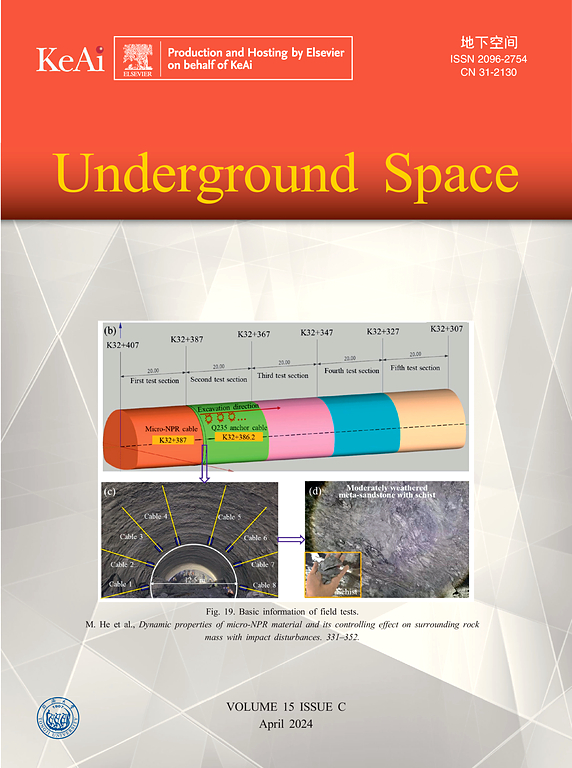Intelligent optimization of TBM cutter spacing and FDEM-based investigation of rock breakage considering brittleness
IF 8.3
1区 工程技术
Q1 ENGINEERING, CIVIL
引用次数: 0
Abstract
Cutter spacing is a key factor influencing the efficiency of TBM operations. Meanwhile, rock brittleness, as a critical indicator of rock fracture, significantly influences fragmentation behavior and rock-breaking efficiency. This study investigates the influence of rock brittleness on rock-breaking through numerical penetration experiments based on the hybrid finite-discrete element method (FDEM) and proposes four intelligent hybrid models to optimize cutter spacing. The results show that as the rock brittleness index (BI) increases from 4.731 to 32.588, the count, depth, width, and proportion of tensile cracks increase, and crack propagation shifts from horizontal to oblique orientations. Moderate cutter spacing (90–110 mm) is optimal for generating tensile cracks. The rock-breaking force increases significantly with higher BI; for instance, at 80 mm spacing, the maximum force for rock with a BI of 13.134 is 5.51 times that for rock with a BI of 4.731. The influence of BI on cutter work and specific energy (SE) is more substantial than the effect of cutter spacing. As BI increases, both cutter work and SE rise considerably. Among the proposed models, the particle swarm optimization and extreme gradient boosting (PSO-XGBoost) model demonstrates the highest performance, achieving an R2 of 0.994, VAF of 99.418%, RMSE of 0.987, and MAPE of 5.217% on the test datasets. An optimization method for cutter spacing is proposed based on this model.
TBM刀距智能优化及基于fdem的脆性破岩研究
刀距是影响掘进机作业效率的关键因素。同时,岩石脆性作为岩石破裂的重要指标,对岩石破碎行为和破岩效率有显著影响。基于有限-离散元混合方法(FDEM),通过数值侵彻实验研究岩石脆性对破岩的影响,提出了四种智能混合模型来优化刀距。结果表明:随着岩石脆性指数(BI)从4.731增加到32.588,拉伸裂纹的数量、深度、宽度和比例均有所增加,裂纹扩展方向由水平向斜向转变;适度的刀具间距(90-110毫米)是产生拉伸裂纹的最佳选择。随着BI的增大,破岩力显著增大;例如,在80 mm间距下,BI为13.134的岩石的最大受力是BI为4.731的岩石的5.51倍。BI对刀具功和比能(SE)的影响大于刀具间距的影响。随着BI的增加,切削功和SE都显著增加。其中,粒子群优化和极端梯度增强(PSO-XGBoost)模型的性能最好,在测试数据集上的R2为0.994,VAF为99.418%,RMSE为0.987,MAPE为5.217%。在此基础上提出了一种刀具间距优化方法。
本文章由计算机程序翻译,如有差异,请以英文原文为准。
求助全文
约1分钟内获得全文
求助全文
来源期刊

Underground Space
ENGINEERING, CIVIL-
CiteScore
10.20
自引率
14.10%
发文量
71
审稿时长
63 days
期刊介绍:
Underground Space is an open access international journal without article processing charges (APC) committed to serving as a scientific forum for researchers and practitioners in the field of underground engineering. The journal welcomes manuscripts that deal with original theories, methods, technologies, and important applications throughout the life-cycle of underground projects, including planning, design, operation and maintenance, disaster prevention, and demolition. The journal is particularly interested in manuscripts related to the latest development of smart underground engineering from the perspectives of resilience, resources saving, environmental friendliness, humanity, and artificial intelligence. The manuscripts are expected to have significant innovation and potential impact in the field of underground engineering, and should have clear association with or application in underground projects.
 求助内容:
求助内容: 应助结果提醒方式:
应助结果提醒方式:


